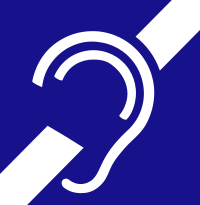
Photo from wikipedia
The purpose of this study was to test the hypothesis that listeners with frequent exposure to loud music exhibit deficits in suprathreshold auditory performance consistent with cochlear synaptopathy. Young adults… Click to show full abstract
The purpose of this study was to test the hypothesis that listeners with frequent exposure to loud music exhibit deficits in suprathreshold auditory performance consistent with cochlear synaptopathy. Young adults with normal audiograms were recruited who either did (n = 31) or did not (n = 30) have a history of frequent attendance at loud music venues where the typical sound levels could be expected to result in temporary threshold shifts. A test battery was administered that comprised three sets of procedures: (a) electrophysiological tests including distortion product otoacoustic emissions, auditory brainstem responses, envelope following responses, and the acoustic change complex evoked by an interaural phase inversion; (b) psychoacoustic tests including temporal modulation detection, spectral modulation detection, and sensitivity to interaural phase; and (c) speech tests including filtered phoneme recognition and speech-in-noise recognition. The results demonstrated that a history of loud music exposure can lead to a profile of peripheral auditory function that is consistent with an interpretation of cochlear synaptopathy in humans, namely, modestly abnormal auditory brainstem response Wave I/Wave V ratios in the presence of normal distortion product otoacoustic emissions and normal audiometric thresholds. However, there were no other electrophysiological, psychophysical, or speech perception effects. The absence of any behavioral effects in suprathreshold sound processing indicated that, even if cochlear synaptopathy is a valid pathophysiological condition in humans, its perceptual sequelae are either too diffuse or too inconsequential to permit a simple differential diagnosis of hidden hearing loss.
Journal Title: Trends in Hearing
Year Published: 2017
Link to full text (if available)
Share on Social Media: Sign Up to like & get
recommendations!